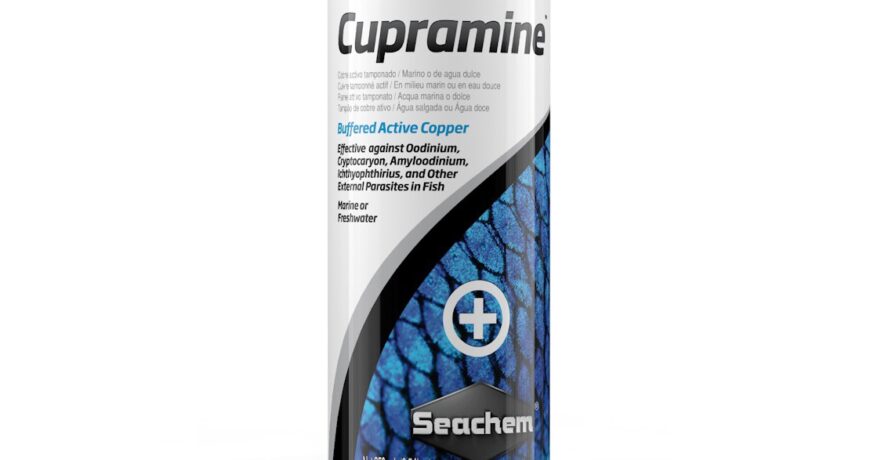Copper is the preferred agent for the eradication of Oodinium, Cryptocaryon, Amyloodinium, Ichthyophthirius, and other external parasites in fish.
Soluble copper salts dissociate in water; copper then precipitates as copper carbonate and copper hydroxide. The consequently necessary repeated dosing is an
inconvenience that results in a dangerous accumulation of copper in the filter bed. This copper is potentially lethal to fish, makes invertebrate culture difficult or impossible, and interferes with the biological filter’s full potential.
Chelated copper is sequestered, uncharged, and inactive. Although this keeps it in solution, it is so ineffective that it must be used at ten times greater concentration than ionic copper. The high chloride content of marine water
contributes to the formation of chloride based complexes of copper; it is these complexes that actually account for the effectiveness (albeit limited) of copper chelates and the eventual deposition of copper in the filter bed. Since chelated copper is uncharged and neutral, it is readily absorbed by fish. Although relatively nontoxic, if enough chelated copper accumulates in fish tissue it can cause long term problems. The reliable measurement of chelated copper is a problem with many copper kits and even known concentrations of chelated copper are less meaningful than those of unchelated copper. Chelated copper is very difficult to remove, except by massive water changes or with CupriSorb™
Citrate copper is very weakly chelated, and the high calcium and magnesium content of marine water rapidly displaces copper from the chelate, making citrate copper only a marginal improvement over ionic copper.
Cupramine™ contains an organic complex which leaves the cupric charge (Cu2+) fully active. This organic component prevents the deposition of copper, inhibits its absorbtion by fish, but does not interfere with action against parasites.
Cupramine™ is buffered and is non-shocking. It is less toxic to fish than any other copper preparation, but more toxic to parasites. It is readily measured by any copper kit and easily removed with activated carbon or other adsorbents.
Cupramine™ is a truly better copper formulation that safely eradicates ectoparasites of both freshwater and marine fish.It is buffered and amine-complexed and has all the advantages of both copper sulfate and chelated copper, but none of the disadvantages. Just like copper sulfate, it is fully
charged (ionic) and effective at low concentrations. Just like chelates, it is nontoxic and is not precipitated in the filter bed. However, unlike both, there is more than a four-fold concentration gap between the therapeutic dose and the toxic dose. Unlike chelates, it is easily removed by carbon.
Unlike copper salts, it does not precipitate in the filter bed. Unlike other copper products it is both highly effective and safe in freshwater as well as marine water. It does not damage the filter bed. Cupramine™ has gained wide
acceptance both by aquarists and public aquaria as the copper agent of choice.
SPECIFiCATIONS: Cupramine™ contains 10,000 mg/L of copper. This copper is organically complexed and buffered. Unlimited shelf life.
ACTION: Cupramine™ eradicates Oodinium and Ich at 0.1–0.2 mg/L, Cryptocaryon at 0.25–0.35 mg/L, Trematodes and other parasites at 0.4–0.5 mg/L. With a
10–14 day exposure at 0.4 mg/L most infestations will be eradicated and secondary bacterial and fungal infections will be controlled.
TOXICITY: Used as directed, Cupramine™ is not toxic to fish. While some invertebrates have shown tolerance for Cupramine™, it should be considered toxic to invertebrates and they should be removed prior to treatment. Invertebrates should not be returned until several days after a test kit shows no copper. Fish exposed to 0.8 mg/L have shown no ill effects beyond increased respiration. No lasting ill effects have been observed.
MONITORING: Cupramine™ has been designed so that monitoring is less critical than with other coppers. In most situations, using the product as directed should suffice. If monitoring is indicated, Cupramine™can be measured
with most copper kits available. Seachem has its own kit, MultiTest:™ Copper, which has been designed specifically for Cupramine™, though it tests all forms of copper.
RECOMMENDATIONS: UV sterilizers, ozone, and chemical filtration should be turned off during treatment. To insure against reintroducing parasites, all new fish should be treated in a quarantine tank. All new invertebrates should be quarantined (but not treated) for at least two weeks. In relatively new tanks with large quantities of coral, some copper may fall out of solution, but will redissolve as more product is added. In tanks that have a high accumulation of precipitated copper, the addition of Cupramine™ may release significant quantities of this copper into solution. In such cases, use smaller doses and monitor copper using MultiTest:™ Copper test kit. In tanks
with large quantities of fresh crushed coral or tanks with high calcium concentrations (>400 mg/L), some Cupramine™ may fall out of solution prematurely and redosing may be required.

